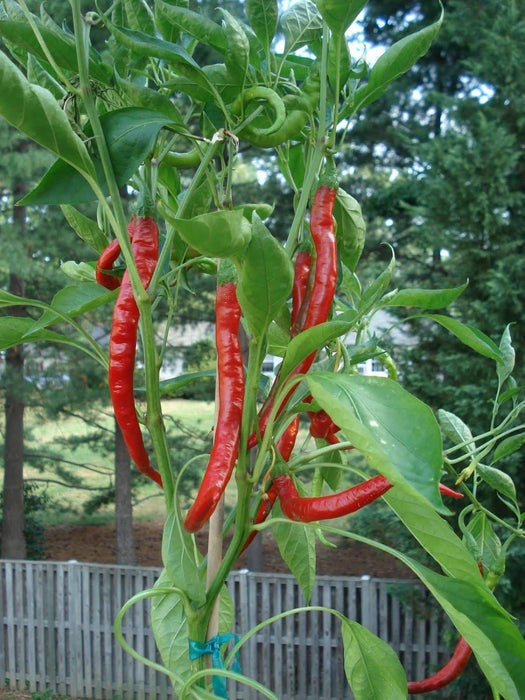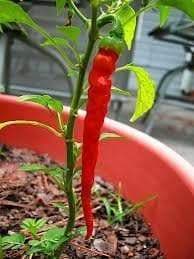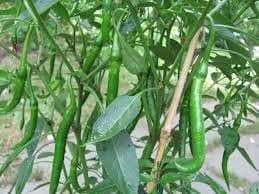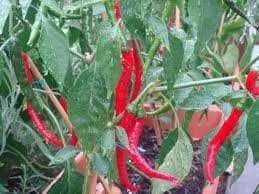
Cayenne Long Red Thin, Pepper SEEDS , Capsicum Annum,
Original price
$ 2.10
-
Original price
$ 20.10
Original price
$ 2.10
$ 2.19
$ 2.19
-
$ 18.69
Current price
$ 2.19
Most orders are processed by the next day
Select your desired size and/or color from the available options.
Cayenne pepper - Heirloom, Organically Grown !
Chili Pepper
The cayenne pepperâalso known as the Guinea spice, cow-horn pepper, aleva, bird pepper, or, especially in its powdered form, red pepperâis a hot chili pepper used to flavor dishes
This is truly an heirloom as the Cayenne is known to be Pre-Columbian in origin. It is said to be named after the Cayenne River in French Guyana.
This is a gorgeous, prolific pepper that will be happy in the garden (and even happier in pots of all sorts of sizes) - once it goes red, it dried very well also. When spun in a blade blender after well dried, you can make wonderful red pepper flakes! And yes, they are really hot!
Cayenne Long Red Thin Pepper (70 days)
A hot, zesty and pungent organic pepper that is 6" long, but only a 1/2" wide. Don't let the size fool you, these kids pack a punch that will put a zing in any dish. You have heard the song "come on baby light my fire"? Well they just might have been talking about this Cayenne Pepper because it will surely light your mouth a fire.
Use them to make sauce,Dry them and ground them as a peppering spice. I love seeing a kitchen with bright red dried organic chilies hanging along the rafters with the braided garlic. This is always a sign of a good cook and excellent gardener.
A versatile pepper, they are used for pickling, canning or drying. A nice, hot variety that reaches 30,000 to 50,000 Scoville Units.
The cayenne pepper, also called the bird pepper or Guinea pepper, is a popular hot chili pepper used for flavoring and medicinal purposes. It is a cultivar of the genus Capsicum annum, and a relative to the bell pepper, habanero, jalapeno and others.
For mass production, it is dried, ground, then formed into cakes and baked; then ground again and made into the fine ground cayenne pepper commonly sold in shaker bottles in spice aisles around the world. It is also sold as red pepper flakes and a main ingredient in many hot sauces.
Cayenne also has a reputation for being good for your health, being high in vitamins A, B, C, calcium and potassium.
Instructions
Planting
Starting From Seeds
1
Spread newspaper over your work surface.
2
Fill the peat pots with starting medium or potting soil to about an inch from the tops of the pots. Set the pots on a tray.
3
Moisten the soil and the pots with water. Allow time for the water to drain through and then pour out the water that collects in the tray.
4
Place four seeds in the center of each pot and cover with a thin layer of soil.
5
Put the tray of peat pots into a plastic bag and seal it. Place the bag of pots in a warm location out of direct sunlight. The optimum temperature for germination is 80 to 90 degrees Fahrenheit.
6
Check the pots daily. When the seedlings emerge, remove the bag.
7
Place the seedlings in a sunny, south-facing window. Use fluorescent lighting if you don't have enough window space. Place the seedlings as close as possible to the fluorescent tube.
8
Clip out the weakest or smallest seedlings when they are about 3 inches tall, leaving only one seedling per pot.
9
Water once a week or as often as necessary to keep the soil moist but not soggy. Always pour off any water that collects in the tray. Water with half-strength liquid fertilizer every other week.
Transplanting
10
Harden off the transplants by setting them outdoors in a shady location for only a couple of hours at first, gradually lengthening the time outdoors and amount of sunlight over a period of seven to 10 days.
11
Dig a hole, using a trowel, large enough to accommodate the peat pot. The soil level in the peat pot should be level with the surrounding soil.
12
Tear off the upper part of the peat pot away so that it doesn't extend above the soil level. This prevents the peat pot from wicking water away from the roots of the plant. Set the pot in the hole.
13
Fill in around the peat pot with soil and firm gently with your hands.
14
Plant the next and each additional plant 12 inches from the previous plant. Water thoroughly once all seedlings are transplanted.
Peppers first come in green. Cayenne peppers are not fully ripe until they are a deep red color. They can still be enjoyed when green, but they will not have reached their full capacity of spiciness. If you prefer a more mild pepper, harvesting early is good for you.
Select your desired size and color from the available option
Chili Pepper
The cayenne pepperâalso known as the Guinea spice, cow-horn pepper, aleva, bird pepper, or, especially in its powdered form, red pepperâis a hot chili pepper used to flavor dishes
This is truly an heirloom as the Cayenne is known to be Pre-Columbian in origin. It is said to be named after the Cayenne River in French Guyana.
This is a gorgeous, prolific pepper that will be happy in the garden (and even happier in pots of all sorts of sizes) - once it goes red, it dried very well also. When spun in a blade blender after well dried, you can make wonderful red pepper flakes! And yes, they are really hot!
Cayenne Long Red Thin Pepper (70 days)
A hot, zesty and pungent organic pepper that is 6" long, but only a 1/2" wide. Don't let the size fool you, these kids pack a punch that will put a zing in any dish. You have heard the song "come on baby light my fire"? Well they just might have been talking about this Cayenne Pepper because it will surely light your mouth a fire.
Use them to make sauce,Dry them and ground them as a peppering spice. I love seeing a kitchen with bright red dried organic chilies hanging along the rafters with the braided garlic. This is always a sign of a good cook and excellent gardener.
A versatile pepper, they are used for pickling, canning or drying. A nice, hot variety that reaches 30,000 to 50,000 Scoville Units.
The cayenne pepper, also called the bird pepper or Guinea pepper, is a popular hot chili pepper used for flavoring and medicinal purposes. It is a cultivar of the genus Capsicum annum, and a relative to the bell pepper, habanero, jalapeno and others.
For mass production, it is dried, ground, then formed into cakes and baked; then ground again and made into the fine ground cayenne pepper commonly sold in shaker bottles in spice aisles around the world. It is also sold as red pepper flakes and a main ingredient in many hot sauces.
Cayenne also has a reputation for being good for your health, being high in vitamins A, B, C, calcium and potassium.
Instructions
Planting
Starting From Seeds
1
Spread newspaper over your work surface.
2
Fill the peat pots with starting medium or potting soil to about an inch from the tops of the pots. Set the pots on a tray.
3
Moisten the soil and the pots with water. Allow time for the water to drain through and then pour out the water that collects in the tray.
4
Place four seeds in the center of each pot and cover with a thin layer of soil.
5
Put the tray of peat pots into a plastic bag and seal it. Place the bag of pots in a warm location out of direct sunlight. The optimum temperature for germination is 80 to 90 degrees Fahrenheit.
6
Check the pots daily. When the seedlings emerge, remove the bag.
7
Place the seedlings in a sunny, south-facing window. Use fluorescent lighting if you don't have enough window space. Place the seedlings as close as possible to the fluorescent tube.
8
Clip out the weakest or smallest seedlings when they are about 3 inches tall, leaving only one seedling per pot.
9
Water once a week or as often as necessary to keep the soil moist but not soggy. Always pour off any water that collects in the tray. Water with half-strength liquid fertilizer every other week.
Transplanting
10
Harden off the transplants by setting them outdoors in a shady location for only a couple of hours at first, gradually lengthening the time outdoors and amount of sunlight over a period of seven to 10 days.
11
Dig a hole, using a trowel, large enough to accommodate the peat pot. The soil level in the peat pot should be level with the surrounding soil.
12
Tear off the upper part of the peat pot away so that it doesn't extend above the soil level. This prevents the peat pot from wicking water away from the roots of the plant. Set the pot in the hole.
13
Fill in around the peat pot with soil and firm gently with your hands.
14
Plant the next and each additional plant 12 inches from the previous plant. Water thoroughly once all seedlings are transplanted.
Peppers first come in green. Cayenne peppers are not fully ripe until they are a deep red color. They can still be enjoyed when green, but they will not have reached their full capacity of spiciness. If you prefer a more mild pepper, harvesting early is good for you.
Select your desired size and color from the available option
LET OUR CUSTOMER SPEAK FOR US

![[Seeds] - Caribbeangardenseed](http://caribbeangardenseed.com/cdn/shop/files/gift-card-gift-card-1_1024x1024_dfa857db-9150-4315-a362-7f0bb3fb9c47_60x28.png?v=1703978838)



